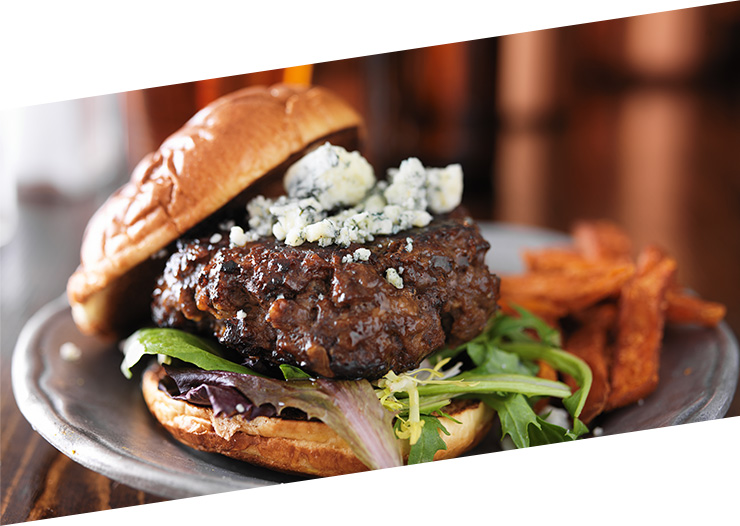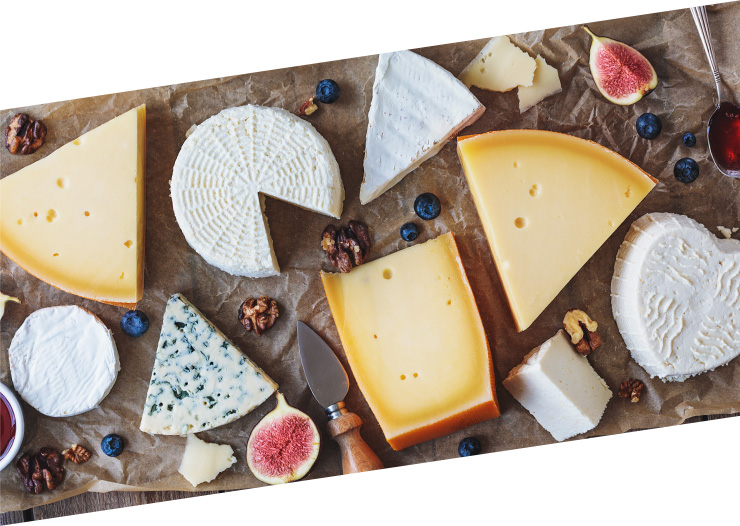What’s Trending: Blue Cheese and Cotija Cheese
Americans love cheese. In the last decade alone, per capita cheese consumption is up 13% according to the International Dairy Foods Association. And, as the cheese category grows, it’s also expanding in terms of varieties.
Sure, Americans still eat a lot of American cheese, cheddar cheese and mozzarella, but more adventurous and global taste buds have diversified the category greatly in recent years. For example, blue cheese and Cotija cheese are becoming more popular than ever in the United States, and it’s showing up in demand for these two products.
Bluegrass Ingredients supplies blue cheese and Cotija cheese in two formats: concentrated pastes and powders. They’re great in everything from seasonings and sauces to dips and soups. They’re also great for blending and can easily serve as the core flavor profile in innovative new products. Our Agile Kitchen™ team developed this FAQ on blue cheese and Cotija cheese to help product developers understand the flavor profiles and potential uses for these two cheeses.

What’s the Origin Story of Blue Cheese and Cotija Cheese?
Blue Cheese
The origin of blue cheese is not entirely clear. We know it dates back to ancient times, and we’re pretty sure it occurred alongside the development of Roquefort cheese in France, but specifics beyond that are few. What we do know for certain is that blue cheese is characterized by the blue/green veins running through it. These veins are created by the presence of Penicillium mold, which is added to the cheese during the aging process. The mold gives blue cheese its pungent flavor and aroma, and contributes to its crumbly texture.
Cotija Cheese
It’s easier to trace the origins of Cotija cheese because it was named after the Mexican town of Cotija in the state of Michoacán. Cotija cheese has been a part of Mexican culinary traditions for generations, and it is still a staple in many Mexican dishes today. It is made from cow’s milk and is known for its hard and crumbly texture, as well as its salty and savory flavor.

What’s the Flavor Profile of Blue Cheese and Cotija Cheese?
Blue Cheese
How do you describe such a unique cheese? Let’s start with the adjectives bold, complex and distinctive. The first impression of blue cheese is often a sharp and pungent tanginess, which is followed by a creamy and slightly crumbly texture that adds to the cheese’s overall appeal. As you continue to savor the cheese, you’ll notice earthy and savory undertones that contribute to its complexity. The aroma of blue cheese is equally distinctive and can be detected from a distance.
Cotija Cheese
The first thing you’ll notice when tasting Cotija cheese is its salty notes. The cheese is often salted during production, which provides a bold and flavorful taste. Alongside the saltiness, Cotija cheese also has a savory/umami flavor, which comes from the fermentation and aging process. Cotija cheese also has a subtle tanginess that balances the cheese’s saltiness.

How Can I Easily Add Blue Cheese and Cotija Cheese Flavor to Food Products Without Dealing with Handling Cheese?
Consumers love cheesy foods, but let’s be honest, adding cheese to a formula is quite the manufacturing challenge. That’s where Bluegrass Ingredients comes in. We’ve perfected the development of cheese powders and cheese concentrates that are easy to incorporate and provide exceptional flavor, mouthfeel and aroma.
For Cotija cheese, we offer both paste and concentrate formats. For blue cheese, we have an extensive line that includes:
- BDF0099 Blue Cheese Powder
- CNC0012 Blue Cheese Concentrate Factor 10
- NP22157 Blue Cheese Enhanced Dried Concentrate
- NP21128-2 Blue Cheese Enhanced Paste Concentrate
Both powdered and paste formats deliver the dynamic cheesy taste consumers love, and the usage decision between formats comes down to the application and manufacturing environment. When used as a seasoning, powdered blue cheese and Cotija cheese is the ideal format. But in a wet system such as dips, dressings and sauces, paste formats may prove desirable. Contact us and we’ll look at your processes and product and determine the best format for our cheese concentrates.

What Applications are Popular for Blue Cheese and Cotija?
Blue Cheese
This strongly flavored cheese is perfect in a variety of applications:
- Sauces, Dressings and Dips: Blue cheese is a key ingredient in many sauces and dressings. It adds depth and creaminess to wing sauces, dipping sauces and salad dressings such as the classic Buffalo sauce.
- Snack Foods: Consumers crave intense seasonings on their snack foods, and blue cheese powder provides it.
- Prepared Entrees: Using blue cheese powder or paste in products such as macaroni and cheese elevates flavor intensity and creates more complex cheese sauces.
- Bakery Foods: Blue cheese powder can be added to doughs, especially biscuits, to create a more savory offering.
- Soups: Added to a dry soup mix, blue cheese powder can impart complex flavors in a soup such as broccoli cheese.
Cotija Cheese
The saltiness of this cheese adds the perfect seasoning to multiple applications:
- Prepared Entrees: Cotija cheese obviously works well in any sauce on a prepared Mexican dish. However, the cheese can also be used in traditional entrees such as macaroni and cheese to intensify the saltiness of the sauce.
- Frozen Vegetables: Season frozen vegetables, such as corn, with a powdered Cotija to deliver a convenient take on trending Elotes.
- Soup: Develop a corn chowder soup mix that delivers the taste of Cotija cheese combined with sweet corn.
- Sauces: Formulate a queso sauce blend that creates a rich, flavorful and salty taste.
- Mediterranean-Inspired Dips: Cotija cheese can mixed with Greek yogurt, lemon juice and herbs for a tangy vegetable dip.

What About Making a Cheese Blend?
Yes! Blue cheese especially lends itself to blending with other cheeses. Here are a few ideas.
- Blue cheese + cheddar cheese: This blend offers a complex contrast between the boldness of the blue cheese and the creaminess of the cheddar. Used in a variety of dips, sauces and dressings.
- Blue cheese + cream cheese: Mixing these two cheese powders or pastes can serve as the flavor base of a vegetable dip or cracker spread.
- Blue cheese + mozzarella: This blend yields a creamy and slightly salty dip that’s perfect for dipping bread, pizza crusts and vegetables.